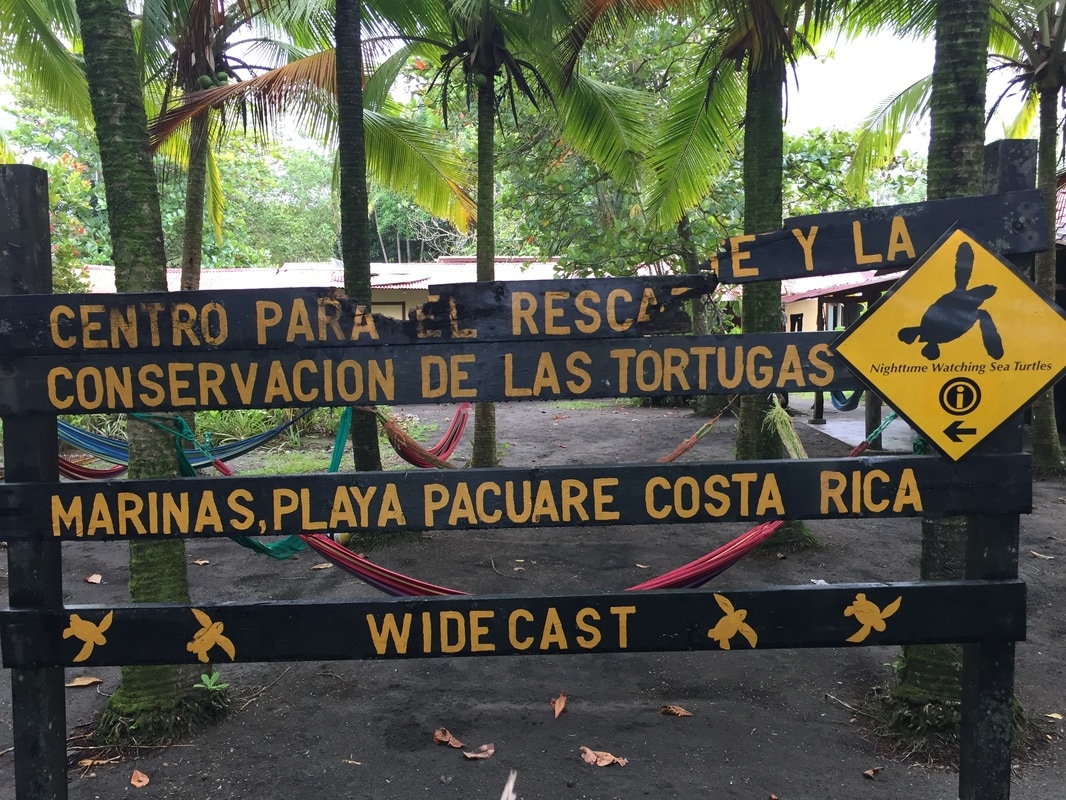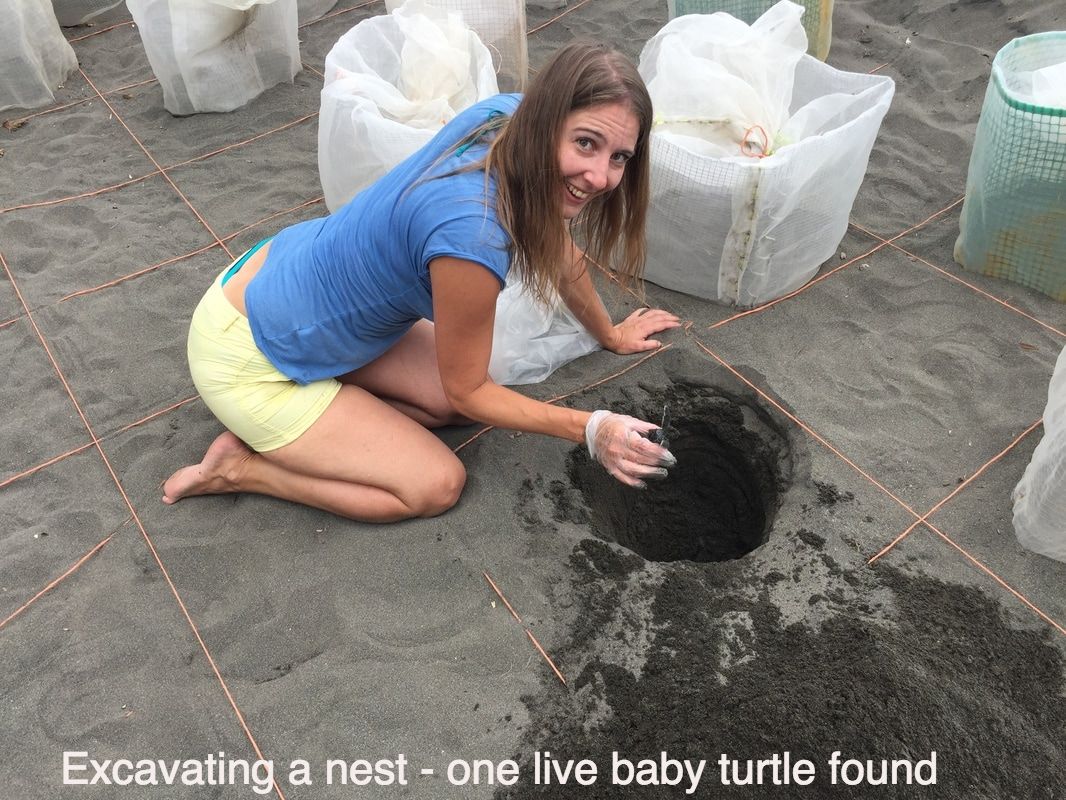Volunteering in marine conservation in Costa RicaHave you ever helped bringing baby turtles to the world? I have! Hundreds of them. And it was one of the most rewarding experiences in my life. Almost 10 years ago, I wanted to do something meaningful with my vacation days. At that time, volunteering and voluntourism was nowhere near where it is today. Nowadays, volunteering is trendy and everybody does it, even though often for the wrong reasons. 10 years ago, I’ve spent 2 weeks in a very remote area in Costa Rica, in a campsite at the beach for the sole purpose to help protect the many turtles nesting at those beaches. This experience never left my mind, even when volunteering in other projects, Costa Rica was always a very fond memory. So, last year I just had to go back there and do it all over again. Different people, different turtles - but nonetheless rewarding and meaningful. Why? Well for one, it is a unique experience to witness these giant sea turtles (leatherback turtles are around 2m long) nest on the beach or seeing baby turtles (about 7cm long) hatch and do the run for the ocean. But also, doing 4h walks in the sand at night without any lights is more exiting than you would imagine. And spending 2 weeks at the beach, on a little remote half island with only around 40 locals and no electricity except solar power, water from water tanks and no cell phone reception or wifi is just the best thing to relax and recharge your batteries. But let’s begin with some facts. Why is it even necessary to have these projects? Sea turtles are one of the most ancient species on earth, and all the 7 known living species are nowadays endangered. Sea turtles come out of the water to lay their eggs at the beach, usually during night time, because bright lights disturb them. They lay around 70-140 eggs, depending on the species of turtles. After around 60 days, the baby turtles hatch and start their very long run for life. They have to get to the water without being eaten by crabs or birds, then they have to swim quite some time to get to areas where they can rest, hide under seaweed and basically just have the time to grow up. This can take up to 10 years or more and there are many dangers, like sharks, ocean pollution or fishing nets that can kill turtles. These years are called „the lost years“ among scientists, as not many evidence of turtle movements are available for this time. Ten to fifty years after they hatched, they reach sexual maturity and start mating and reproducing. The female turtles come back to the beaches where they were born to lay theri eggs - and the circle of life starts all over again. But besides the many natural threats like birds, sharks or crabs (that may even dig into the sand to eat the baby turtles still in their eggs) as well as coastal development (e.g.erosion), there are so many manmade threats. Global warming is one of those, but there are more. Turtles can get entangled in fishing nets (legal and illegal ones) and drown, they get sick due to polluted oceans, they may die because they eat plastic floating in the ocean or they simply get killed by humans who poach them for the shell to make jewelry for tourists, to get their meat or the eggs. Eating turtle eggs has a long cultural tradition in Costa Rica, so it is no wonder there are many poachers who make a living hunting for eggs at night. This would not generally be a giant problem, if the turtle population would be high enough. But sea turtles unfortunately are critically endangered and need all our help to stay in this world (since it was us who put them in that situation in the first place). Both times, I stayed for two weeks at this awesome program called „La Tortuga Feliz“ (The happy turtle). It was founded by late Paul Lepoutre, a dutch guy who more or less built the whole camp himself. An amazing and very inspiring person So what do volunteers do in this program? One task is to patrol the beach at night, together with a local guide. During the 4h shift, volunteers cover a distance of 10km while looking for nesting turtles. If you find a nest or a turtle digging the nest, the volunteers dig out all eggs, collect them and bring them back to the hatchery where all details (amount of eggs, date, time etc.) are written down before the eggs will be reburied in the sand in a designated area in the hatchery. Or you are staying in the hatchery at night or daytime to protect the eggs from poachers (who might dig out eggs put until 3-4 days after nesting) or crabs and check the nests for hatchlings. If you have hatchlings, the measurement begins. They hatchlings are being counted, weighed and measured and then released at the beach to start their run for the ocean. There is also the task of beach cleaning and recycling. Volunteers grab some trash bags and start collecting all trash found at the beach. You would be astounded to know what you can find there. Besides the usual plastic bottles, bottle caps and the very dangerous plastic straws, you also find lots of medicine glass bottles, brooms, puppets and what not. This trash is very dangerous. Birds may pick that up because it is shiny or it can land in the oceans where it is eaten by the animals there. Plastic will never dissolve and it will kill ocean life. Turtles for example normally eat jellyfish. Plastic bags floating in the ocean look exactly like jellyfish to them. Because of the little hooks on their tongues, turtles can’t let go of plastic bags once they started eating them. Even though they realize it is not food, they have no other option but to swallow it completely. Keep that in mind the next time you buy something wrapped in plastic… The day after a nest has hatched and the baby turtles have made their way to the ocean, it is time for the excavation of the nest. The camps biologist digs up the nest to see if there are some live baby turtles left who did not make it out yet because they were a little slower than the others and to check if all eggs have hatched. Usually, there are some undeveloped eggs, some eggs where the turtles died inside due to bacteria or fungus next to all the empty shells of the hatched eggs. Everything is counted and exactly written down. One night, we even found a live stage 3-4 (almost fully developed but not able to hatch) turtle in one of those eggs, and it was an albino turtle. Check the images to see how that looks like. It was only barely alive and had no chance of making it in this world. That was heartbreaking, even more than to find dead turtles in their eggs who were not fully developed. After everything is noted, all these eggs and shells are buried deeply at the beach, under some wood and covered with sand, in the hope that the dogs will not dig them out again. When there were many hatched nests the day before, the volunteers get to help with excavations. Besides the daily patrols and hatchery shifts or the beach cleaning you have plenty of time to relax and recharge. During the day, you can go swimming, lay in the hammocks, play cards, read or engage in conversations with the locals who work for the project. At weekends there usually are excursions by boat to the near Pacuare Reserve where you can spot birds, monkeys, snakes, frogs or sloths. All the local guides who work for the project used to be poachers before that. Now they help to save the turtles. And throughout the years, many other projects like this started along the beaches of Costa Rica, the whole caribbean and the pacific coasts of the americas. During those 10 years between my two stays, the turtle population improved and some species made it from the critically endangered to the endangered list. So you see, volunteer work helps but it takes a long time and the turtles still need all our help to get off all of those endangered lists for good. How can we help from here? You can either book your stay at La Tortuga Felix now(or some other turtle project from LAST/Widecast for example) or start doing what you can from home to help save our oceans. One big help is to strictly recycle, to reduce or even better refuse to use plastic. You don’t need plastic straws, to-go cups or plastic bags from the mall. Just bring your own reusable cup/mug to get to-go coffee, bring your own reusable bag for groceries shopping and if you cannot exist without straws, buy one made from stainless steel and carry it in your handbag. And of course, try to reduce your trash generally as much as possible up until you reach a zero waste lifestyle. In the food section, you can make the effort to check where your fish products are from and how they are produced. If you don’t want to live without fish, insist on only buying MSC labelled fish that comes from sustainable fishing. Also, check the WWF labels and endangered species list to check, which fish you should not eat at all. If you have read all this and made it up to here, don’t be shy, leave a comment and let me know who your are. And of course: thank you for helping to save our oceans and all life within.
0 Comments
Leave a Reply. |
about me ...I am a swiss photographer (www.sustainable.photography), a travel, wildlife, volunteer and outdoors addict who cares about zero waste, the environment and simply our planet.
older posts ...categories ...
All
|
 RSS Feed
RSS Feed 


